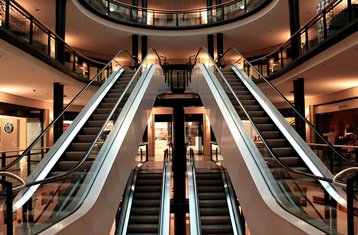Ecommerce was on the rise even before 2020, but the global pandemic introduced a special kind of helium to online retail. Ecommerce sales soared to $870 billion in the US in 2021, up a staggering 50.5 percent from pre-pandemic levels in 2019.
Retailers had already accepted and were planning adjustments to a gradual uptick in online buying that tracked increased consumer comfort with technology and digital platforms (and the growth of Amazon). The pandemic quickly shifted those plans into overdrive, and distribution centers became the engine propelling the change. But a digital infrastructure built for a more traditional retail model lagged against the sudden shift, and that engine sputtered.
The new retail landscape requires new thinking. Data center downtime – an inconvenience in a brick-and-mortar world – is a death sentence as more transactions are consummated online. As the customer base expands beyond a retailer’s physical footprint, so does the task of order fulfillment, bringing national and even global responsibilities to regional distribution centers. And those responsibilities become a 24x7 test of the organization’s digital, physical, and human infrastructure.
Looming over it all are the inevitable increases in energy consumption and costs that come with the amped-up digital presence required for ecommerce. More data centers and network edge facilities, more cloud resources, and round-the-clock demand for IT services add up to higher electric bills and a more significant carbon footprint. These are the same issues facing the data center industry broadly, but they’re hitting retailers with a unique suddenness. Even the most successful brands have struggled to keep up.
Operational objectives in opposition
These can feel like daunting challenges. The need for more computing is at odds with the desire to reduce costs and emissions, but there are technologies available to help organizations meet the demands of their customers and their responsibilities to the environment.
We worked with a major global retailer – one of the world’s leading designers and producers of athletic shoes, apparel, equipment and accessories – to help navigate these challenges and meet three objectives:
- Satisfy consumer demand with high-volume, next-day, and expedited product delivery options;
- Effectively handle higher e-commerce transactional speeds; and,
- Improve the energy efficiency of all systems to reduce operational expenses and support zero-carbon and zero-waste efforts.
These may seem like unrelated outcomes, but they all are problems that can be, and were, mitigated with intelligent digital infrastructure solutions and architectures.
This retailer was working across its platforms to reshape the customer experience with a focus on upgrading the data center and edge facilities supporting the company’s logistics center. Built in the 1990s, the data centers were not equipped to support the volume and speeds required to keep pace with shifting consumer trends, including increasing ecommerce acceptance. Aging power and cooling systems were inefficient and contributed to unacceptable outages and downtime risks.
Simply put, the data centers were no longer meeting the needs of the business.
Infrastructure upgrades make it possible
Solving these problems required a large-scale, multi-year revitalization project that consolidated and replaced all legacy data center equipment and systems. This included all cooling units and uninterruptible power supply (UPS) systems – a patchwork quilt of outdated, inefficient, and disconnected infrastructure equipment from multiple manufacturers.
The new cooling and UPS technologies deployed were tailored to the needs of each facility. These included scalable, high-efficiency, transformer-free UPS systems for the data center and smaller, edge-friendly models for smaller spaces, as well as room, row, or small-space cooling solutions. All systems included connectivity features that allowed intelligent networking to optimize operation.
The upgraded cooling systems operate at a third of the costs of the units they replaced and reduced facility costs for maintenance and power consumption while also reducing the physical footprint. With scalable power systems in place, the company can now transition on the fly without downtime from as little as 4 kVA to 160 kVA based on power needs. Likewise, power can be scaled down as compute is removed, lowering energy consumption. Redundant cooling and power ensured maximum uptime to support the facilities’ 24x7 operations. In-row cooling and in-rack UPS systems, coupled with a sub-zero enclosure, create a repeatable, stable data center in a box deployable to all new logistic center facilities.
Monitoring tools and software allow detailed reporting and tracking of all key metrics from every connected system. By tracking compressor hours, power curves, inverter health, and battery alerts, the organization can see trend lines of overall system health for a more predictive maintenance strategy, allowing the company to locate issues before they become operational problems.
The results have been striking. There was a 50 percent reduction in utility costs and $200,000 saved due to reduced downtime, along with reduced capital expenditures and enhanced, 24x7 customer responsiveness capabilities. The systems provide real-time monitoring to spot and correct any outage risks, and the retailer’s data centers can run without facility power for extended times, allowing for controlled shutdowns if necessary. All these results were achieved through intelligent infrastructure upgrades.
The shifting digital landscape can be intimidating if not overwhelming, especially in the retail space. Fortunately, there are partners with the expertise and solutions to help retailers navigate these changes and prepare for what’s next.
Learn more at Vertiv.com
More from Vertiv
-

Sponsored How commissioning can help overcome today’s challenges in healthcare IT expansion
Vertiv's Chris Dansa explores the key benefits of taking a commissioning approach to healthcare IT construction
-

DCD>Talks Power & Cooling Enabled Sustainability with Fred Rebarber, Vertiv & Tor Kristian Gyland, Green Mountain
Dive into power and cooling enabled sustainability demand with this DCD>Talk from our live DCD>Connect Silicon Valley event
-

Columbus Crew's New Stadium, Lower.com Field, Counts on Vertiv Infrastructure to Maximize Fan Entertainment
A look into a case study where Vertiv's infrastructure was implemented in the design of a professional soccer stadium



